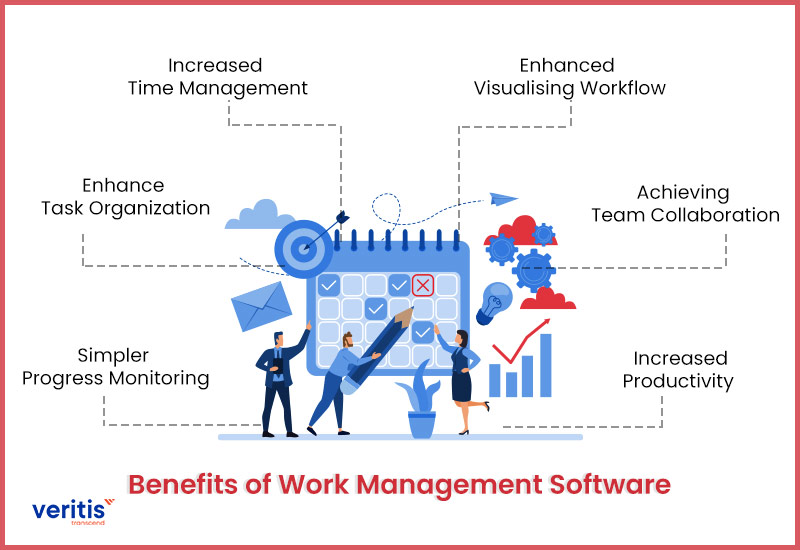
In the workplace, task management software is helpful for individuals and teams. Additionally, task management software is more critical than ever as an increasing number of teams switch to remote work and search for solutions that support remote working conditions and communication.
You may increase your productivity by using work management software, but not every tool is appropriate. Knowing which aspects are most crucial can help you choose the ideal solution for your company. Before selecting a new work management system, consider the following features.
You can take on projects of multiple sizes with project management apps and technologies, making it easier to set deliverables, milestones, and precise objectives. Moreover, both teams and individuals can use project management apps.
Is there any distinction between task management, project management, business management, and work management as terms or tools? Although we have been using them interchangeably without thinking about it, they are not synonyms.
On the other hand, job management tools are primarily concerned with adding and finishing various activities connected to work. Whereas business management apps exist to support risk prediction, increase team productivity, and facilitate task completion.
What About Tools for Work Management, then?
One such application should ideally include everything mentioned above and assist teams (not individuals) in organizing anything from complete workflows to straightforward non-project-related tasks. The goal of work management software is to assist you in organizing your tasks and your team without being constrained by a project or technique.
In an ideal world, a single application would address all of the aforementioned issues and assist teams (not individuals) in managing anything from complex workflows to straightforward non-project-related chores. Without the constraints of a project or a methodology, a work management tool can assist you in organizing your team and your work.
All of the following should ideally be included in one platform that aids teams (not individuals) in organizing anything from complex workflows to straightforward non-project-related tasks. Without the constraints of a project or a methodology, task management tools are designed to help you organize your work and your team’s activities.
Before moving on to our list of the best tools to assist you in managing your workload, let’s first go through the concept of work management software.
Useful link: 9 Data Security Best Practices for Your Business
What is Work Management Software?

Work management is a technique that aids businesses in developing a practical workflow framework that works for all levels of the organization. It tries to streamline various company procedures so that internal and virtual teams can function effectively to increase profitability. To enhance your team productivity and business results, use work management software to plan, monitor, organize, and review projects and non-project tasks. Then, to find the flaws in the current structure, you thoroughly evaluate current operational activities.
But how did the demand for work management software as a separate tool arise?
People frequently look for project management (PM) software to organize their professional work. The problem is that most of them are involved in activities other than projects. So instead, they choose an app that will let them the schedule, monitor, manage, and organize their work, even the tasks that fall beyond the purview of workforce management software.
In this situation, they require a tool that will enable them to move their work outside the confines of a project’s fixed framework. This flexibility is made possible by work management software, which enables work to be completed and monitored outside the bounds of a project or methodology without depending on customers, strict budgets, or other duties.
Additionally, workflow management tools incorporate processes that aid firms in coordinating their efforts and completing them flawlessly. The benefits of such tools are:
- Increased organizational effectiveness
- Removal of redundant components from the system
- Fulfillment of customer requirements
- Effective usage of resources
- Good team collaboration
The benefit of work management solutions is that they may be applied to some of the main ideas of a project that fall outside the purview of project management apps.
Teamwork and collaboration are critical components of projects. But that requires work management to manage the person. And it would be more accurate to refer to it as teamwork management rather than work management solutions.
This strategy (teamwork management) combines the techniques and procedures of work management solutions with the equipment and frameworks of project management apps to deliver the best outcomes for your company.
Useful link: All You Need to Know About Top 10 Security Issues in Cloud Computing
Benefits of Work Management Software

As we’ve already indicated, a good work management application needs to incorporate a variety of capabilities for managing tasks, projects, and businesses. Therefore, the first and most obvious advantage of such a workflow management system is that you can stop paying for various platforms and consolidate all your work into one.
You won’t constantly switch between several apps to do your work.
What other advantages might this change to a comprehensive work order management software bring? Let’s look at this quickly:
1) Simpler Progress Monitoring
You’ll find it easier to keep track of your progress on tasks, the progress of your team members, and the progress of your clients and external partners.
2) Enhance Task Organization
Whether they are related to a project, you can manage and organize your tasks with the right tool. The most effective tools have functions that may be used to track, organize, and collaborate on your activities so that you can finish them on schedule.
3) Increased Time Management
Workflow management systems typically aim to aid in time tracking and increase productivity. As a result, you’ll be able to predict time correctly, keep up with your team’s hours, and simply do more with improved time management.
4) Enhanced Visualising Workflow
All excellent platforms offer a variety of views to enable you to view your work from multiple perspectives. For instance, a Kanban board can be used to track workflow management tools stages and transfer completed items to the appropriate columns. In contrast, Gantt charts can be used to gain a general perspective of your long-term projects.
5) Achieving Team Collaboration
The ability for teams to work without effort is a must for any product worth it is salt. With a work management solutions platform, you can collaborate with your team on a new level, whether uploading a file for everyone to see or starting a discussion thread in the comments section.
6) Increased Productivity
Work management software also improves efficiency at the office by streamlining decision-making. Because all the necessary information is in one place, you can always make decisions quickly and with full knowledge.
A competent manager can detect potential risks and put workable solutions in place. With workforce management software, managers may enhance their risk mitigation strategies and employ all the resources at their disposal to produce efficient countermeasures. This improves the team’s general effectiveness and enables task management tools to use their resources efficiently.
Difference Between Work Management Tools and Project Management Tools
Work management and project management are occasionally confused since they have comparable functionalities. Although work management and project management apps might be complementary, the former encompasses a much larger range of activities.
Project management is different from work management in that work management helps teams manage both direct and indirect business components, such as projects, work processes, daily activities, and performance management. In contrast, project management is a branch of work management that focuses on overseeing particular projects.
Work management focuses on project scope management, but project management is a much broader profession. This is the actual difference between the two.
Project management and work management are not interchangeable, although both have advantages for teams. These two methods for managing people, time, and tasks will help you get excellent outcomes.
Useful link: What is a Disaster Recovery Plan? How Confident Are You in Implementing it?
Best 12 Features for Work Management Software

1) Easy-to-Use Interface
It won’t help you much if your employees don’t use the work management software.
Your employees will be more likely to utilize the work management software without IT staff’s training or assistance if it is intuitive. As a result, you will be more productive and spend less time controlling others.
Before making any decisions, you should read user evaluations to determine how user-friendly a task management system is.
2) Mobile Accessibility
Using work management software with mobile access makes keeping track of your employees’ tasks much simpler.
If a work management system is accessible via a smartphone, employees are more likely to use it. Since they can reply as needed without having to open the desktop version. This flexibility is crucial for small organizations with frequently traveling or remote-working workers.
3) Structured Task Planning
Organizing all tasks in an organized way is one of the most challenging components of managing employees. Without a task management system approach, this might be challenging. For this reason, managers can organize and prioritize all necessary activities for each employee using work order management software with a structured task planning component.
4) Task Scheduling
It’s critical to effectively schedule your tasks once you’ve made a list of those you need to finish in a certain time period. Employees can rank their tasks according to urgency using a sound system. By prioritizing and establishing a time limit for each activity, managers should be able to manage this scheduling component with simplicity.
5) Task Tracking
Managers may monitor the status of each employee’s project and, if necessary, provide feedback with the help of a practical task-tracking feature. This is a crucial tool for increasing productivity since it enables you to identify potential trouble spots for staff and offer them the assistance or support, they need to finish the assignment.
6) Task Communication
Work management software absolutely must have real-time task communication. As a result, even if they operate remotely or in different time zones, employees may oversee every project stage from beginning to end. In addition, without switching to another platform, teammates can communicate.
7) Integrated Time Tracking
The work management software that organizations select must have an integrated time-tracking capability because more businesses are utilizing a remote or hybrid workforce. In this way, you can keep tabs on their hours and productivity regardless of where they are or whether they are in the office.
Fortunately, several time management programs are out there that easily interface with well-liked work management programs. Keylogger and Screen meter are two examples. In addition, you should be on the lookout for work management software that can display recurring work reports. If you require a work management software report for an employee for a day or a week, you should be able to access it quickly and without having to wade through a tonne of data.
8) Collaborative Features
As they say, time is money. Your employees are given tasks to complete, and you expect them to work hard the entire day or week. However, most businesses still have trouble increasing productivity without micromanaging every worker’s desk work.
To secure that everyone working on a project has access to the same data, time worker management software must be collaborative. In this manner, it is simpler to manage schedules and prevent staff confusion.
9) Import/Export Capabilities
This feature should be at the top of your list if you’re seeking worker management software that can interact with other programs in your organization. Making the change from one software to another as seamless as feasible and sharing any information at the push of a button are priorities.
It shouldn’t be challenging to carry out a task, such as sending finished assignments to another department. Likewise, any time you import data from another program, you shouldn’t run into any issues.
10) Manuals and Guides
Information should be accessible on the platform as efficiently as feasible. Finding the solution should be as simple for anyone needing assistance with workforce management software.
While some businesses appreciate long manuals and guidelines, others want straightforward solutions without the extra information lying about. Of course, depending on your demands inside your firm, you are free to choose which function you would prefer to have instead. But this feature should be on your list.
11) Customizable Workspaces
Within the organization, different employees will handle numerous tasks and focus on various things. Therefore, it is crucial to offer fully customized workspaces to accommodate each individual need or desire.
For instance, if a person handles sales, they would probably like tasks linked to sales at the top of their list. On the other hand, information about finances ought to come first for someone whose attention is on that subject.
12) Analytics for Task Reporting
It’s essential to be aware of where your business stands constantly. By highlighting issue areas and chances for improvement, analytics for task reporting can give you the knowledge you need to run a successful firm.
All employees, from the top of the corporate ladder to the bottom, need access to this information to run your business properly. This will enable everyone to make well-informed decisions.
Conclusion
Work management software enhances efficiency and corporate communication while improving an organization’s performance. It assists businesses in effectively allocating and managing resources while inspiring team members to accomplish much more in a limited amount of time.
It’s safe to assume that finding your company’s ideal work order management software is no simple task. So, decide you won’t regret it a month from now by considering everything, including pricing, features, and the number of collaborators.
Consulting professionals can be an excellent option if you’re keen to find the best answer for your organization but aren’t sure where to start. An expert IT consulting company can simplify the situation and direct you toward the best option for your company. This is where Veritis comes in place.
Veritis, the recipient of the Stevie Award, offers very valuable solutions to clients that are responsive, integrated, trustworthy, and tailored. Many companies, including Fortune 500 companies, have trusting partnerships with Veritis. So, get in touch with us, and we’ll provide you with the most outstanding services and the best solution.
Got Questions? Schedule A Call
Additional Resources: